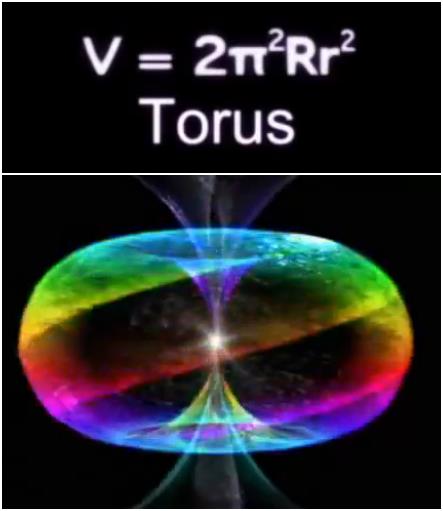
"In geometry, a torus (pl. tori) is a surface of revolution generated by revolving a circle in three dimensional space about an axis coplanar with the circle. If the axis of revolution does not touch the circle, the surface has a ring shape and is called a ring torus or simply torus if the ring shape is implicit.
When the axis is tangent to the circle, the resulting surface is called a horn torus; when the axis is a chord of the circle, it is called a spindle torus. A degenerate case is when the axis is a diameter of the circle, which simply generates the surface of a sphere. The ring torus bounds a solid known as a toroid. The adjective toroidal can be applied to tori, toroids or, more generally, any ring shape as in toroidal inductors and transformers. Real-world examples of (approximately) toroidal objects include doughnuts, vadais, inner tubes, many lifebuoys, O-rings and vortex rings.
In topology, a ring torus is homeomorphic to the Cartesian product of two circles: S1 × S1, and the latter is taken to be the definition in that context. It is a compact 2-manifold of genus 1. The ring torus is one way to embed this space into Euclidean space, but another way to do this is the Cartesian product of the embedding of S1 in the plane. This produces a geometric object called the Clifford torus, surface in 4-space.
The word torus comes from the Latin word meaning cushion." [https://en.wikipedia.org/wiki/Torus|Wikipedia, Torus]
See Also
3.03 - Vortexial Motion
3.10 - Vortex Motions result in Appearance of Form
3.14 - Vortex Theory of Atomic Motions
3.23 - Hydrodynamic Equations - Vortex Motions
4.5 - Triple Rotary or Vortex Motions
5.1 - Vortex Formation
5.2 - Vortex Motions in Resonators
5.3 - Vortex Motion in Ether and Atoms
5.4 - Vortices are born of Motion and Matter is concentrated Vortices
5.5 - Double Vortices
5.6 - Vortex Forming Spheres
5.9 - Vortices Form Linked Atoms
6.16 - Fourteen Vortices
10.08 - Corner Vortices
Double Vortex
Figure 2.13 - Swirling Vortex around Neutral Centering Shaft
Figure 3.18 - All Motion is Vortex Motion
Figure 3.21 - Vortex or Gyroscopic Motions as Conflicts or Antagonisms between Light and Dark
Figure 3.22 - Vortex or Gyroscopic Motions as Conflicts or Antagonisms between Light and Dark Zones
Figure 3.23 - Vortex or Gyroscopic Motions as Conflicts or Antagonisms between Light and Dark Zones
Figures 3.31 - Vortex Orthogonal and self-contained Motions - Structure
Figures 3.32 - Vortex orthogonal and self-contained motions - cross-section
Figure 4.5 - Compound Gyroscopic or Vortex Motions
Figure 5.10 - Introductory Degeneration of Mass via Interpenetrating Vortices
Figure 5.13 - Babbitt Atom constructed of Compound Vortexial Motions
Figure 5.3 - Vortex or Gyroscopic Motion is Natural and occurs ubiquitously
Figure 5.4 - Vortex and Gyroscopic Motion on One Plane then on three forming Sphere
Figure 5.5 - Double Interpenetrating Vortex
Figure 5.6 - Double Double Vortices as Stages of Attraction
Figure 5.7 - Vortices on Three Planes 90 Degrees to Each Other
Figure 5.8 - Initiatory Generation of Mass via Interpenetrating Vortices
Figure 6.0.5 - Cube with Vortices showing Structural Relations
Figure 6.1 - Orthogonal Vortex Motion as Structural base of Cubes
Figure 7.1 - Step 1 - Wave Vortex Crests at Maximum Polarization
Figure 7.2 - Step 2 - Vortex Formation about a Single Axis
Figure 7B.12 - Sympathetic Affinity Attraction forming Vortex
Figure 10.05 - Three Orthogonal Planes where Six Gyroscopic Vortices Converge
Figure 10.06 - Vortices in Cube extending in to and out from Center
Figure 10.07 - Corner Vortices and Vectors
Figure 13.05a - Complex Vortex Rotational Dynamics
Karman vortex street
Part 03 - Polarity Creates Rotating Vortex
The Action of Force is Spiro-Vortex
Tripartite Motion of Earth
vortex
vortex ring
Water Vortex
